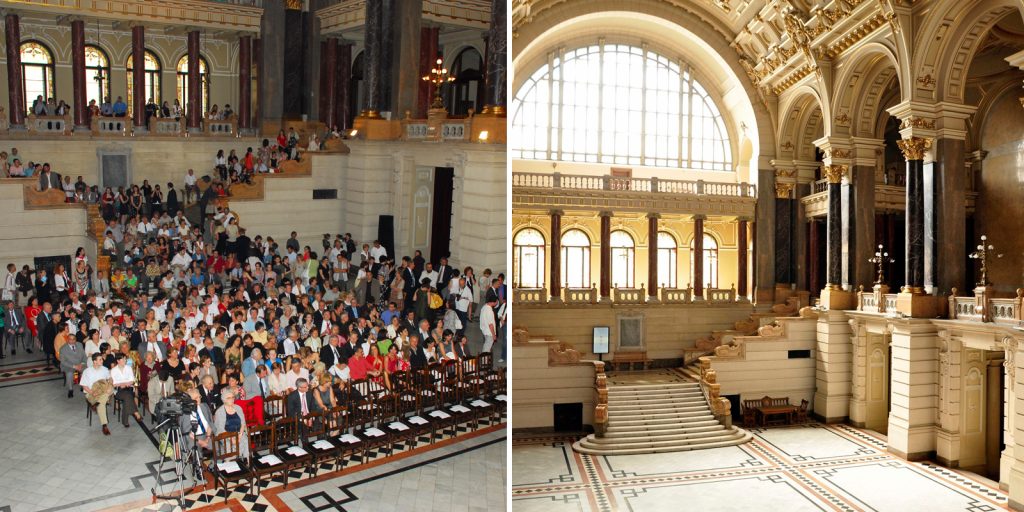Museum of Ethnography on the move in Budapest – VIDEO

The Museum of Ethnography’s new home in City Park in the green heart of Budapest – a facility to satisfy the needs of both professionals and the public – will be completed in 2021 as part of the Liget Budapest Project (Best Futura Mega Project award nominee, Cannes 2017). The design of this exciting new building has won two International Property Awards in the categories of best public service architecture, Europe, and best public service architecture, Global. Currently operating behind closed doors in its building opposite the Hungarian Parliament, the museum is now preparing full-force for the move. Though the vast array of non-traditional tasks involved does not allow for public access to many interesting, behind-the-scenes processes, the museum would nevertheless like anyone interested to be able to follow events as they shape museum history.
Closed building
The current building of the Museum of Ethnography is known worldwide for much more than its large-scale exhibitions. Its impressive interiors, too, have garnered much attention, appearing in such memorable films as Evita, Spy, and Inferno. What many people do not know is that the museum, which has been in operation since 1872 and therefore represents one of Europe’s oldest ethnographic institutions, has occupied the former Hall of Justice building since as early as 1973 (following several relocations). Rightly proud of its collection, while also open to the opportunity of renewal, the social science museum will for the first time be housed in a brand new building – one that meets the needs of professional and visitor alike, and where, plans are, numerous treasures previously hidden in museum storerooms will gain new visibility.
Though from the outside, the current building seems peaceful, inside, preparations for transporting the museum’s numerous artefacts are proceeding full steam everywhere – including former, well-known exhibition spaces. Each article – whether a unique piece from Oceania or a group of hundreds of wine jugs from the museum’s enormous ceramics collection – must be picked up, cleaned, identified, and photographed. The scale of the job is difficult to imagine: some 250,000 artefacts and million odd archived documents, photographs, and photographic negatives must all be moved during the period to come.
“Our institution closed its doors to the public in December of 2017. In the past year and a half, our staff have handled nearly 200,000 of the museum’s artefacts,” notes museum director Lajos Kemecsi. “Objects are in the process of leaving their collections, and though our staff cannot lose themselves in this work at present, it is presenting us with the opportunity of answering a number of questions.” The museum’s professional team are now occupied in a number of simultaneous pursuits: e.g. conceptualising the permanent exhibitions to be installed in the new building, assigning labour to various architectural and construction tasks, curating the institution’s various collections, and performing the ongoing general audit.
Numerically speaking…
“By the end of 2018, we had gone through almost 200 boxes of dust masks, 550 pairs of rubber and cloth gloves, 1000 square metres of banner cloth, and twice that amount of plastic sheeting. We had also climbed 2400 steps and drunk 660 cups of coffee per person,” Collections Department head Veronika Schleicher summarises her staff’s past 15-months’ experience. “Last year alone, 110,000 artefacts were furnished with QR codes and at least 46,000 digital photographs were taken. The work currently underway feels as mechanical as chopping wood, though some of the objects we are moving have probably been resting in the same places for 40 years,” she adds.

Digitisation
An important part of ongoing archive work consists in the digitisation of approximately 13,000 endangered nitrate-containing photographs. When this work is completed, the museum’s archives will have grown to include some 90,000 total digital records, to which will be added the institution’s 700 drawings and sketches that are currently being scanned. Further digitisation work, including that related to the tapes in the Audio Archive, targets the cause of artefact preservation. There is also much to be done with the museum’s other analogue media: video cassettes in the Moving Picture Collection must be digitised or discarded; the department must decide which devices to keep as artefacts of technological history, etc. Professionals are now engaged in digitising and archiving several hundred reels of tape and Bakelite disks, while the museum’s unique collection of 4000 phonograph cylinders must be given special handling during the move. This latter body of material is the same one that aided the Musicology Institute of the Hungarian Academy of Sciences in creating a map showing where various songs were sung in Hungary 100 years ago.
Conservation
Matters of conservation will be accorded particular attention during this period. The museum’s new Collections Centre will be opening in the vicinity of City Park in 2019. The relocation of the institution’s complex collection will present not only a physical challenge, but also one of reinterpreting museum operations in general. Storage facilities in the new Collections Centre will be realised over more than 10,000 square metres and will involve modern storage systems designed to ensure that space is utilised economically. The museum’s current 3-unit external warehouse base in Törökbálint houses, among other things, its entire Furniture and Lighting, Rituals and Customs, and Ecclesiastical Collections, while the Crafts and Trades, Construction, and Transportation Collections have resided there for some three decades. More than 13,000 artefacts have been prepared in the foregoing period for moving, the more unusual of them including a complete carnival carousel, peasant wagons, and a dugout boat some 7 metres long.

Scientific research and publicity
“Despite the challenges and burdens, we would like to remain present in both public, and professional life,” the museum director asserts. The two areas that define museum scientific work are collections research / artefact identification, and the building of new collections (i.e. both artefacts, and documents) in support of the museum’s contemporary studies program. With no exhibitions to aid them, the results of these endeavours are made visible and accessible to others via other, formerly lower-profile systems, including publications, conferences, and professional/public programmes on the one hand, and the media and online services on the other.
As regards preparations for the new permanent exhibition, museum researchers have assembled a volume entitled Polyphonic Museum: Dilemmas Faced by Ethnography Museums in the Early 21st Century, containing selections translated from the international professional literature. The studies included in the volume map out important topics relevant to contemporary ethnography, analysing the relationship between cultural anthropology and ethnography museums, the role of social science museums, the characteristics of contemporary material culture, and changes in the domains of meaning borne by ethnographic objects. The theoretical approaches reflecting these views are rounded out by a discussion of the curatorial practices applied to concrete exhibitions.
An enormous responsibility
“The material and information that have been accumulating in the Museum of Ethnography over the past 150 years represent an enormous responsibility,” Veronika Schleicher continues. “Our job is to preserve our collections in a manner so fluid and to such a high standard that we can, from time to time, present them via new voices and devices. Many people with a committed interest in our heritage regard these collections as cultural gene banks. For them, ours is a credible source, a depository for answers and solutions.”
The schedule for museum relocation will proceed in parallel with the history of the grand expedition that produced the institution’s first collection: the East Asian field collecting trip of János Xántus, the museum’s first director. Both the collection itself, and the exhibition organised from its material bear as much significance today as they did in previous centuries; and by current plans, the new Museum of Ethnography will open in 2022, the 150th anniversary of the year in which the events in question concluded. Until then, stay tuned!
Source: Museum of Ethnography





